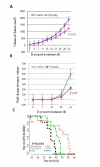A highly invasive human glioblastoma pre-clinical model for testing therapeutics
- PMID: 19055779
- PMCID: PMC2645376
- DOI: 10.1186/1479-5876-6-77
A highly invasive human glioblastoma pre-clinical model for testing therapeutics
Abstract
Animal models greatly facilitate understanding of cancer and importantly, serve pre-clinically for evaluating potential anti-cancer therapies. We developed an invasive orthotopic human glioblastoma multiforme (GBM) mouse model that enables real-time tumor ultrasound imaging and pre-clinical evaluation of anti-neoplastic drugs such as 17-(allylamino)-17-demethoxy geldanamycin (17AAG). Clinically, GBM metastasis rarely happen, but unexpectedly most human GBM tumor cell lines intrinsically possess metastatic potential. We used an experimental lung metastasis assay (ELM) to enrich for metastatic cells and three of four commonly used GBM lines were highly metastatic after repeated ELM selection (M2). These GBM-M2 lines grew more aggressively orthotopically and all showed dramatic multifold increases in IL6, IL8, MCP-1 and GM-CSF expression, cytokines and factors that are associated with GBM and poor prognosis. DBM2 cells, which were derived from the DBTRG-05MG cell line were used to test the efficacy of 17AAG for treatment of intracranial tumors. The DMB2 orthotopic xenografts form highly invasive tumors with areas of central necrosis, vascular hyperplasia and intracranial dissemination. In addition, the orthotopic tumors caused osteolysis and the skull opening correlated to the tumor size, permitting the use of real-time ultrasound imaging to evaluate antitumor drug activity. We show that 17AAG significantly inhibits DBM2 tumor growth with significant drug responses in subcutaneous, lung and orthotopic tumor locations. This model has multiple unique features for investigating the pathobiology of intracranial tumor growth and for monitoring systemic and intracranial responses to antitumor agents.
Figures




References
-
- Lee J, Kotliarova S, Kotliarov Y, Li A, Su Q, Donin NM, Pastorino S, Purow BW, Christopher N, Zhang W, et al. Tumor stem cells derived from glioblastomas cultured in bFGF and EGF more closely mirror the phenotype and genotype of primary tumors than do serum-cultured cell lines. Cancer Cell. 2006;9:391–403. doi: 10.1016/j.ccr.2006.03.030. - DOI - PubMed
Publication types
MeSH terms
Substances
LinkOut - more resources
Full Text Sources
Miscellaneous

